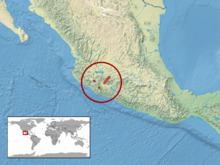Subphylum Vertebrata Suborder Serpentes Rank Species | Phylum Chordata Family Viperidae Higher classification Rattlesnake | |
 | ||
Similar Crotalus lannomi, Crotalus intermedius, Crotalus transversus, Crotalus aquilus, Rattlesnake | ||
Volcano rattlesnakes in search of crotalus pusillus
Crotalus pusillus is a venomous pit viper species found in west-central Mexico. No subspecies is currently recognized.
Contents
- Volcano rattlesnakes in search of crotalus pusillus
- Description
- Behavior
- Geographic range
- Conservation status
- References
Description
Adult males may grow to more than 50 cm (20 in) in length. Females are smaller. The largest recorded length for a specimen is 68.2 cm (26.9 in).
Behavior
Campbell and Lamar (2004) found this species only to be active during the day. Within its range, night temperatures are low and apparently restrict its activity.
Geographic range
It is found in west-central Mexico in the Sierra de Coalcomán of southwestern Michoacán, the Transverse Volcanic Cordillera of west-central Michoacán, and in adjacent Jalisco. It is probably also found in northeastern Colima. The type locality given is "Tancítaro, Michoacán, Mexico, altitude 5,000 ft" (5,000 ft = 1,524 m). It occurs at elevations between 1,525 and 2,380 metres (5,003 and 7,808 ft).
Conservation status
This species is classified as Endangered on the IUCN Red List of Threatened Species with the following criteria: B1ab(iii) (v3.1, 2001). A species is listed as such when the best available evidence indicates its extent of occurrence is estimated to be less than 5000 km2, estimates indicate its range is severely fragmented or known to exist at no more than five locations, and a continuing decline has been observed, inferred, or projected in the area, extent, and/or quality of its habitat. Therefore, it is considered to be facing a very high risk of extinction in the wild. The population trend was unknown when assessed in 2007.
